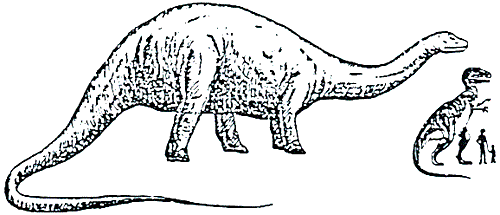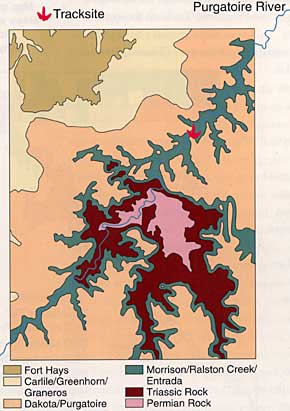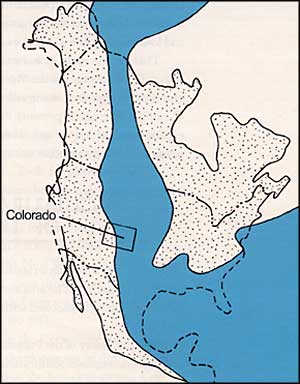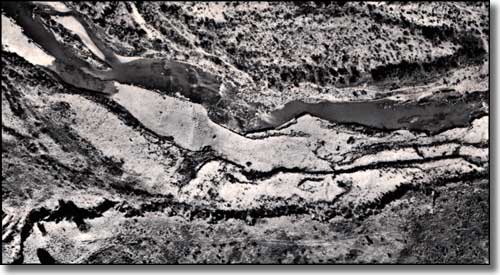
Dinosaur Lake-Picketwire Canyonlands
The Geological Story


Explore the traces left by Brontosaurus and Allosaurus, left behind as they walked along the muddy shoreline of an ancient shallow lake 150 million years ago.
290 to 245 million years ago (during the Permian age), much of Colorado was a low-lying region, and much of that land was covered by a shallow sea that dried up over the years. The Lyons Sandstone is a compressed beach-sand formation that runs along the edge of the Front Range, delineating the long-time shore of that ancient sea. Except for the tracks of early reptiles and spiders, there have been very few fossil remains found in the Lyons Sandstone.
245 to 65 million years ago was the Mesozoic Era, a time period that saw eastern Colorado above and below water at least a dozen times. 245 to 208 million years ago (during the Triassic Period), the Chinle group of sandstones was deposited. The Chinle group is famous in Arizona as being a major part of the scenery at the Petrified Forest and Painted Desert. Near the Oklahoma state line, some early dinosaur tracks have been found in exposed Chinle strata.
208 to 144 million years ago (the Jurassic Period) is the time when dinosaurs were most prevalent throughout the world. This is also the time when the Entrada Sandstone, Bell Ranch/Ralston Creek Formation and the Morrison Formation came into existence. The Entrada Sandstone is a wind deposited formation of fossilized sand dunes, although only a small crocodilian fossil has ever been found in the formation, and that was in Utah, not here.
Overlying the Entrada Formation are two layers of rock very similar to the rock found in the Ralston Creek Formation (of southeastern Colorado) and the Bell Ranch Formation (of northeastern New Mexico). The rocks are representative of the deposits found around the arid coastal lagoons of shallow seaways: they are highly saline with a high gypsum content. Dinosaur tracks have been found in both these formations.
Laid down over the Ralston Creek/Bell Ranch Formations during the late Jurassic age (about 162 to 144 million years ago), the Morrison Formation consists of shales and sandstones (from floodplain environments and river channels) siltstones and shale (from soil-forming environments) and limestone (from lake environments). While the Morrison has produced lots of fossils, fish scale, plant and invertebrate fossils, it also contains the longest dinosaur trackway yet found in North America.

The Cretaceous Western Interior Seaway
During the last period of the Mesozoic Era, the Cretaceous Period (144 to 65 million years ago), a shallow inland sea spread across eastern Colorado. This was the Cretaceous Western Interior Seaway and it extended from the Gulf of Mexico northwestward across the Great Plains, Alberta, Saskatchewan, and the western Northwest Territories to the Arctic Ocean, and included about 2/3's of modern-day Colorado. From oldest to youngest: the Purgatoire, Dakota Sandstone, Graneros Shale, Greenhorn Limestone, Carlile Shale, and Niobrara are formations deposited during the Cretaceous Period.
The Dakota Sandstone Formation is of river and shallow-marine origin. It forms the prominent sandstone cliffs that cap the canyon walls. The rocks are abundant with traces of burrows and invertebrates and the tracks of crocodiles and an Iguanadon-like dinosaur. There are so many tracks in the Dakota Sandstone that this area is sometimes referred to as the Cretaceous Dinosaur Freeway, an extensive area of track-bearing rocks representing a dinosaur migration route along the trampled shoreline of the Cretaceous Western Interior Seaway. These tracks came into existence 50 million years after the tracks that are found in the Jurassic Purgatoire Tracksite (which is what this particular series of pages is about) and they represent an entirely different community of dinosaurs.
The overlying shales and limestones above the Dakota Sandstone are marine depositions from the late Cretaceous and contain some invertebrate fossils. There are no rocks in the area from later times (65 to 2 million years ago - the Tertiary Period) although there are depositions of sand and gravel in the valley bottom from the times of the ice ages. These sands and gravels contain vertebrate fossils of mammoth, bison and other mammals who have lived and died in this area over the last 2 million years.

An aerial view of the tracksite area
